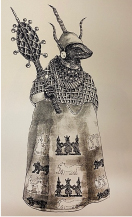Alma Vorster remembered - an orbituary by Professor Pippa Skotnes

Alma Vorster was one of the first two MFA students I supervised, along with my colleague Stephen Inggs in the late 1980s. The other was Jo Ractliffe. For both of us, they were challenging, committed students, engrossed in their work, and possessed of deep inner lives revealed in curious and engaging ways in their prints. Both had a view of a dark side of life, but also of its flipside – they recognised the magical. For Alma, the dark side along with its attendant fears and apprehensions was very much alive in her own life. As an undergraduate student, she appeared as withdrawn, keen not to be noticed, shy, even sullen, but during the years I worked with her she revealed a wonderful sense of humour, a sardonic sense of irony (often aimed at herself) a rich imagination, and a remarkable facility with materials, particularly in printmaking. She found her métier in etching.
As an MFA candidate, Alma was horrified by the idea she would have to write. Having to express herself verbally was difficult, and also implausible, since everything she wanted to say was wrapped up in the images she made. These images seemed to come from an unstable, half formed, constantly transforming universe that escaped definition even as each shape defined its edges with the crispness of a hardground line. Slowly, reluctantly she drew the words out of herself and her MFA, sparse as it is in any kind of theory or art history, remains a beautiful realisation of project in which a young artist presents not only her work to be examined, but an insight into the sources and references that were drawn into conversation with it.

In all my time at Michaelis I never encountered another student with Alma’s facility with intaglio techniques. She was able to lay the finest aquatint, burr the deepest black, create the beautiful grays of a mezzotint and the watery washes of a sugarlift. Her burnished whites glowed with the gentlest tonalities, and her figures, drawn from worlds of shamanic dreams and religious visions were conjured into existence and set to perform on dramatically lit stages, casting deep shadows.

After her MFA, which was awarded with distinction, she, along with Malcolm Payne and myself, started the Axeage Private Press. We wanted to produce editions of prints and books that drew together what we thought of as the ‘literary and the visual’. We worked in a studio at the top of Long Street in Cape Town and, while we were only together there for a few years, the idea of the Axeage Press has endured and it is the imprint under which Malcolm and I still publish prints. Alma taught for many years, on and off at Michaelis in the printmaking section, and the beautiful test plates that she made to demonstrate etching times and processes must be familiar to many generations of students in the department. She and I never kept in close contact in the years and decades after we established separate studios, but I was always aware of her work when she exhibited, and felt a deep sense of connection with her and a bond that resulted from our mutually instructive time as student and supervisor. She taught me much about what it means to try to see through another’s eyes with compassion, and reminded me recently, in a farewell note when I retired from active duty at Michaelis a few months ago, of the precious community we shared in the printmaking workshops of the ‘80s and ‘90s and the ways in which ‘our footprints have mingled’ since then.

Now, like the |xam whose footprints are blown away each by her own wind after death, Alma’s will mingle no longer. I regret, with such sadness, that dark day when she gathered her courage, or when it failed her, and she left this life. I am grateful for knowing her, and for her work which yet survives.
Pippa Skotnes
October 2021
